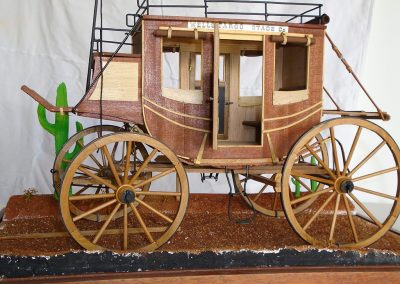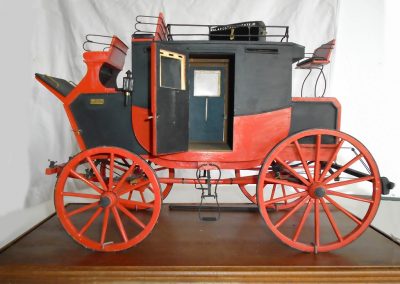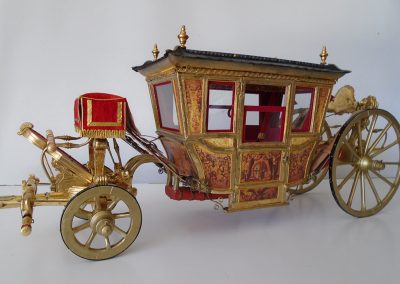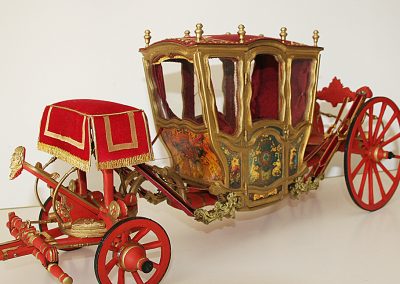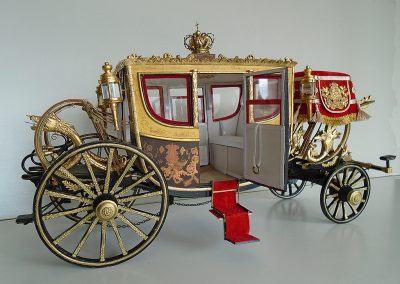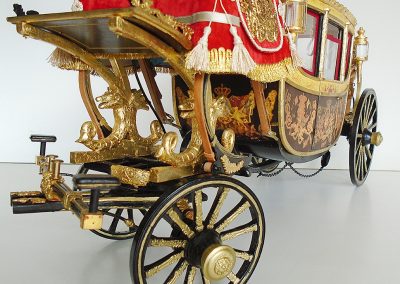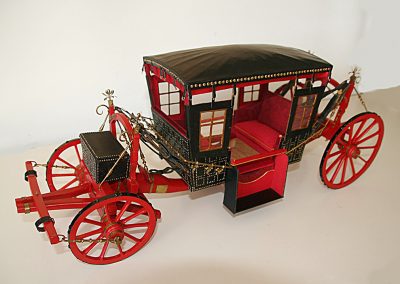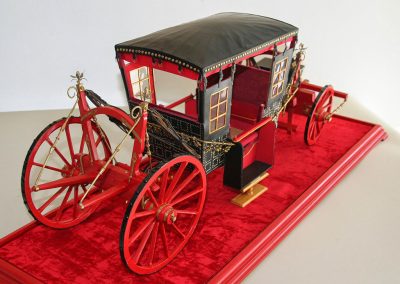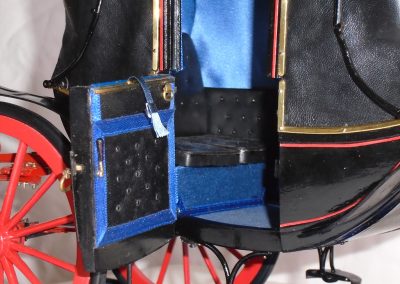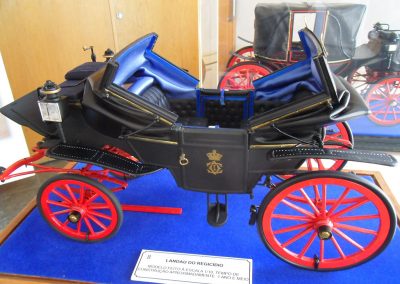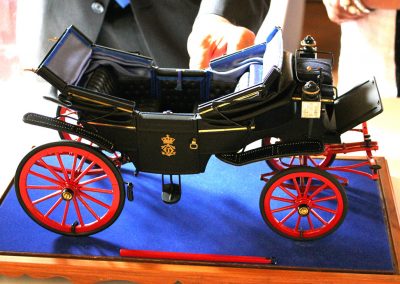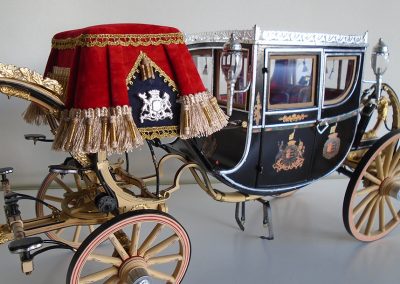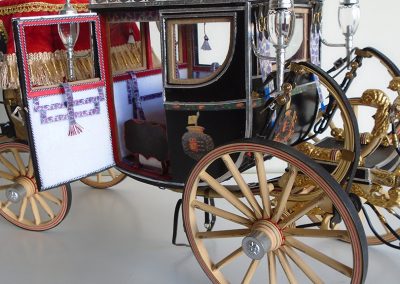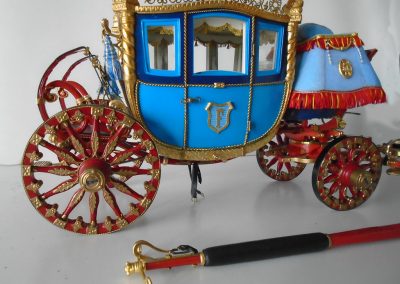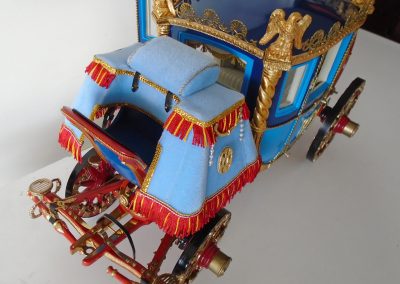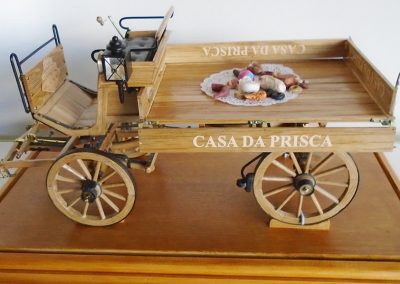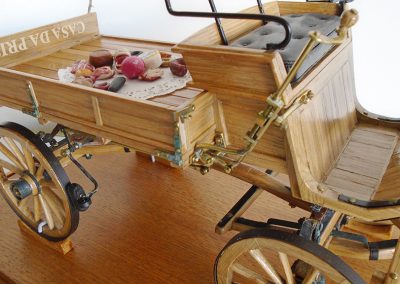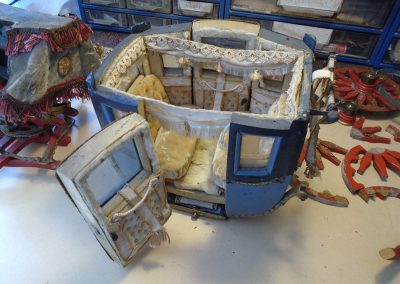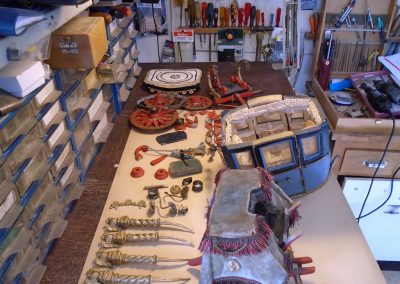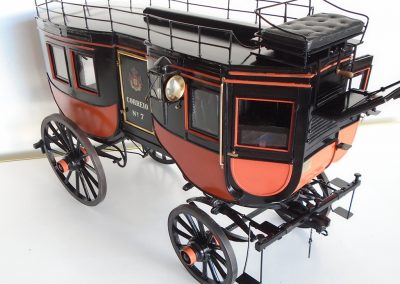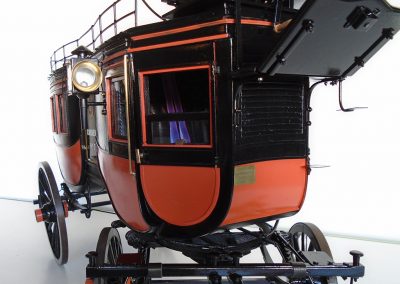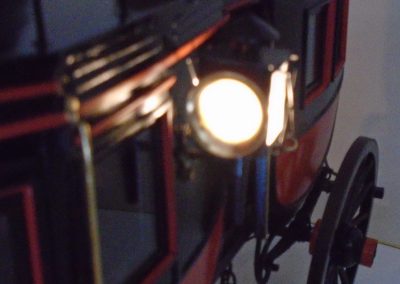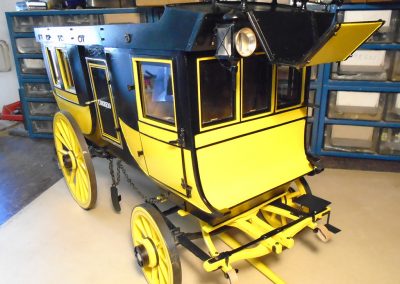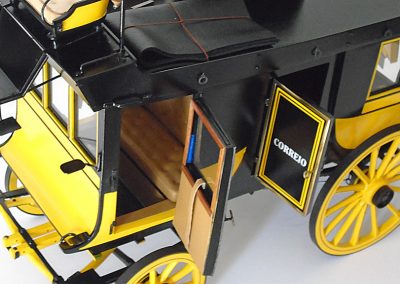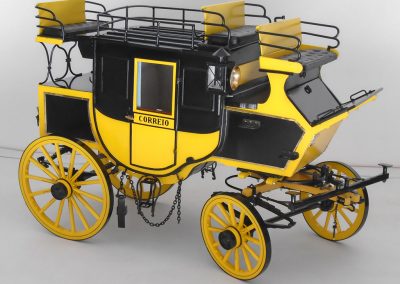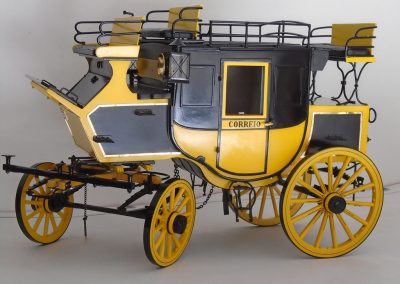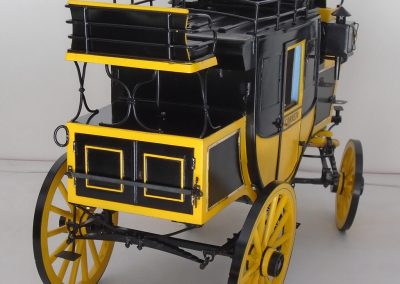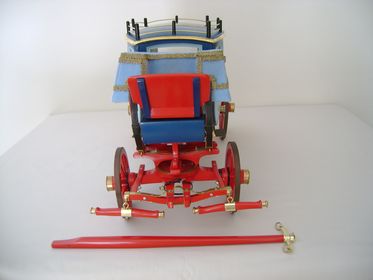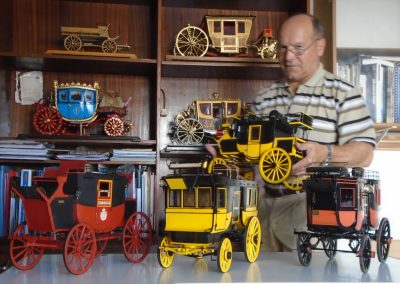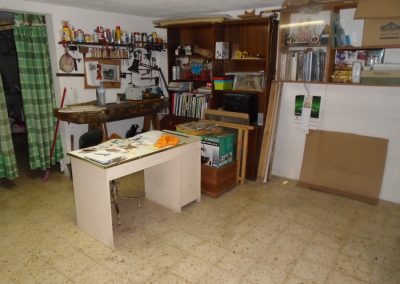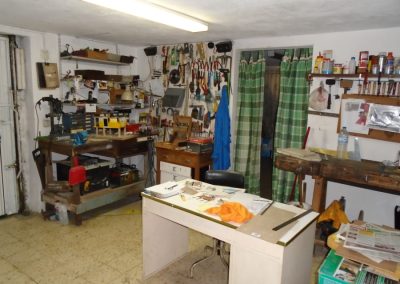Below you can view detailed images and descriptions of José’s model coaches in the order that he built them. Click images to enlarge. The captions and information were contributed by Mr. Brito as well.
Coach No. 1
This first coach was a Wells Fargo American Expedition of the 19th century. The miniature was built from a 1/10 scale Latin Craft Kit about 20 years ago. It was built before José got into Naval ship models. The boats were very bulky and difficult to pack and carry, though. He found this Wells Fargo carriage in a catalog of miniature boats, and decided to try it out.
Coach No. 2
José’s second attempt at building a coach was this Royal Mail Coach. It was his first project built from scratch.
Coach No. 3
This coach is of French origin. Coaches No. 3 and 4 took about a year and a half each to build at 1/10 scale. José noted that he had not yet mastered the gliding of the gold leaf, nor the details of the sculpture.
Coach No. 4
The materials José uses are always the closest he can find to the originals—such as velvet, silks, and apricot fabric.
Coach No. 5
This full-size carriage was the last of the museum collection that was used to transport Queen Elizabeth II of England when she visited Portugal in 1957.
Coach No. 6
Coach No. 6 was the car of Filipe II. It was of Spanish Origin, and transported King Filipe from Madrid to Lisbon in 1619. It took about a month to make the trip. It’s a very unique coach, and the original is the number one coach in the museum’s collection. It was built in Spain in the 17th century.
Coach No. 6
This miniature was made in 1/10 scale, and took two and a half years to build. It was the most difficult model to build out of all in his collection. It was made with natural silk, leather and apricot fabric. The seat has an evacuation system, WC and is built from chestnut wood, beech, metal and iron. All the details of the original are reproduced here.
Coach No. 7
José’s seventh coach model is a Landau of French origin, and was the first official vehicle of Portugal’s first President of the Republic in 1910.
Coach No. 8
Coach No. 8 is a Landau of Regicide. This Landau has a very sad history, because Portugal’s last King, D. Carlis I, was assassinated in it. It is a Landau of Portuguese origin.
Coach No. 8
This miniature was made on a 1/10 scale, and took about a year and a half to build. Everything is functional, such as the doors, windows, lamps, brakes, and suspension—plus the hood is foldable!
Coach No. 9
The ninth coach is a Carruagem of Porto Covo. The carriage is of English origin, Século XI.
Coach No. 10
This is a Napoleonic State Coach built from plans offered by the Fischer Body Craftsman Guild—which was sponsored by General Motors Corporation in Detroit, Michigan in the 1930’s.
Coach No. 10
When José was looking for miniature coaches on the internet, he happened to discover the history of this magnificent coach associated with G.M. The history of the challenge fascinated him immensely, so he bought the original plans in the USA and built this beautiful miniature.
Coach No. 10
These coaches were originally to be built by young craftsmen in a nation-wide contest, with the ultimate winner receiving a 4-year college scholarship. It served as a talent search for future automobile designers skilled in the art of model making.
Coach No. 11
José found the original of this van in a large commercial area doing a promotion for sausages. He found it very funny and unusual, so he asked for permission to take photos and measurements in order to build it on a scale of 1/10.
Coach No. 12
José found this model coach on eBay. It’s an original model made for the G.M. contest, but it was very broken with many pieces missing. So José bought it to restore it. Here you can see it as he received it, and then in its finished form.
Coach No. 12
Most of the original parts were not possible to recover, so many had to be recreated. He took advantage of some of the original pieces, such as the drivers’ seat curtain, but little else. The Fisher Body Craftsman’s Guild story motivated José, and charmed him a lot with G.M.
Coach No. 12
The Craftsmanship Museum has two award winning model Napoleonic coaches built for the Fisher Body Craftsman’s Guild competition.
Coach No. 13
These next two are model carriages of the Malaposta—or Royal Mail coach. Coach No. 13 is a miniature built on 1/10 scale, and it took about a year to build.
Coach No. 13
This coach originally made the connection between Lisbon, Coimbra and Porto—which is about a 300km journey.
Coach No. 13
On the model, every detail is captured along with its function. As you can see, even the coach lights work.
José Cardoso Brito With His Coaches
These four Royal Mail coaches belong to the museum of the Post Office of Portugal. The vehicles are in a very good state of conservation and restoration.
Mr. Brito With One of His Carriages
These miniatures were built to 1/10 scale, like all the others, and each took about one year to build. (Some of José’s other models can be seen in the display case behind him).
Mr. Brito’s Workshop
Mr. Brito’s workshop area is compact, but well organized. He noted that, “Some of the tools are of homemade construction, like hat rods or broken limes. I have included some photos of my workshop.”
Mr. Brito’s Workshop
About his workshop and tools, José said, “All these jobs are done in the garage, not very big, but enough for these constructions. There are not too many tools used, and they aren’t very sophisticated. I have: a watchmaker’s lathe for very small things; a larger lathe for larger things—such as wheels and metal parts; an air compressor and airbrush for the painting; 2 table saws; a Proton mill for very fine and precise things; a Parksaid for cutting thicker wood; a miniature strand for twisting the strings which overlap the windows and interior panels; and various jigs and molds for the railings.”—José Cardoso Brito

